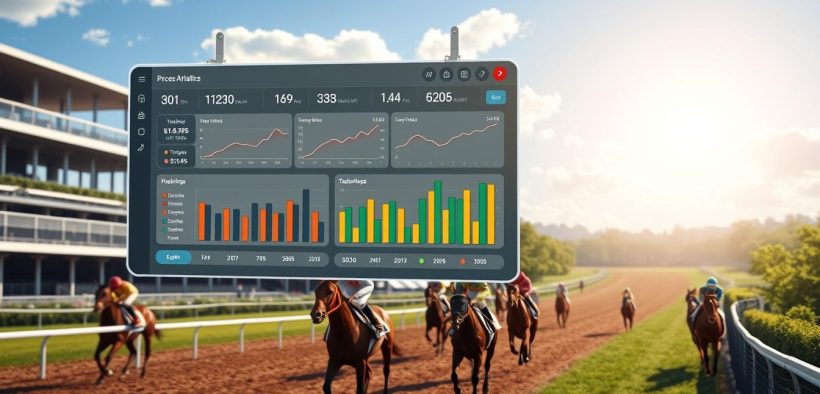Discover Winning Patterns with Our Trainer and Jockey Stats

Discover Winning Patterns with Our Trainer and Jockey Stats
Horse racing thrives on strategy, and savvy bettors know success starts with the right insights. By analyzing performance metrics like win percentages and historical trends, enthusiasts gain a competitive edge. Platforms like EquinEdge simplify this process, offering clear data visualizations that highlight winning combinations.

Recent case studies show how these tools make a difference. For example, one thoroughbred’s improved results aligned directly with a jockey-trainer duo’s 27% win rate over six months. Such patterns help predict outcomes before the gates open.
EquinEdge delivers easy-to-read statistics on earnings, partnership success rates, and seasonal trends. This approach turns raw numbers into actionable strategies. Whether you’re new to the sport or a seasoned fan, understanding these metrics transforms how you engage with every race.
Ready to refine your betting tactics? Dive into data-driven racing insights and uncover opportunities hidden in plain sight.
Understanding the Basics of Trainer and Jockey Stats
Modern horse racing isn’t just about pedigree—it’s about patterns hidden in performance metrics. While speed and stamina matter, long-term success often hinges on how teams adapt to evolving conditions. Platforms like EquinEdge decode these details, transforming complex figures into clear insights.

What Do These Metrics Measure?
Trainer win rates track victories over specific periods, like the past year. Jockey performance reviews span longer timelines, often five years, revealing consistency. These numbers highlight partnerships that thrive under pressure or adapt to track variations.
The Impact on Race Outcomes
Recent shifts in form or strategy often surface in updated statistics. A 15% quarterly improvement in earnings, for instance, might signal a team hitting its stride. Bettors who spot these changes early gain an edge when odds still favor underdogs.
Historical data also exposes how teams perform across distances or weather conditions. By viewing trends through this lens, enthusiasts move beyond guesswork. They build strategies rooted in evidence, not just excitement.
Analyzing Data: Win Percentages and Performance Trends
Unlocking the secrets of racing success starts with understanding key performance indicators. Metrics like win rates and earnings growth reveal patterns that casual observers might miss. Tools like EquinEdge simplify this process by organizing complex figures into intuitive dashboards.

Interpreting Win Percentages and Earnings
A 22% win rate over three months might seem modest, but paired with rising earnings, it signals momentum. For example, teams improving from $15k to $28k in quarterly purses often refine strategies that sustain success. Look for consistency—those maintaining top-three finishes in 30%+ of races typically adapt well to competition.
Earnings per start also matter. A horse averaging $5k per race outperforms peers even with fewer wins. This metric highlights reliability, especially in competitive fields where podium finishes translate to steady returns.
Spotting Trends Across Different Time Frames
Monthly fluctuations can mask long-term progress. A team might show a 10% summer dip but rebound with 35% fall wins due to weather adjustments. EquinEdge’s six-month trend filters reveal these rebounds before odds adjust.
Seasonal comparisons are equally telling. Analyzing year-over-year data helps identify which partnerships thrive under specific conditions. If a duo’s wet-track wins jump from 12% to 27%, wet weather becomes a strategic advantage worth noting.
How to Use Trainer and Jockey Stats in Betting Strategy
Winning strategies emerge when past performances meet present opportunities. Platforms like EquinEdge transform historical racing data into actionable insights, helping bettors identify high-potential combinations. By focusing on patterns rather than hunches, enthusiasts can refine their approach to every race.
Leveraging Historical Data for Smarter Bets
Successful bettors prioritize teams with proven track records. For instance, a duo with a 24% win rate in dirt-track sprints over two years offers reliable value. These partnerships often outperform short-term streaks, especially when earnings per race exceed $4,500 consistently.
Key metrics to track include:
- Three-year win rates for specific race distances
- Earnings growth during similar weather conditions
- Top-three finishes in competitive fields
EquinEdge’s platform highlights how certain pairs excel under pressure. A recent analysis showed teams maintaining 18+ podium finishes annually delivered 35% better returns than average. This data helps users spot undervalued contenders before odds shift.
By combining historical trends with current form, bettors craft strategies that meet their goals. The right information turns guesswork into calculated decisions, building confidence with every wager.
Comparing Performance Metrics Across Racetracks
Racetracks shape outcomes as much as the horses themselves. Surface types, turns, and straightaways create unique challenges that influence results. EquinEdge data reveals how teams adapt strategies to specific venues, turning track quirks into competitive advantages.

Evaluating Trends by Race Class and Distance
Dirt tracks like Churchill Downs favor front-runners, while turf courses at Belmont Park reward late surges. Trainer Linda Rice, for example, boasts a 19% win rate in mile-long turf races but dips to 12% on shorter dirt sprints. These variations highlight why analyzing distance preferences matters.
Recent meets show how layout impacts partnerships. Jockey Irad Ortiz Jr. excels on tight turns common at Saratoga, securing 23% of wins there compared to 15% at wider tracks. Tools like EquinEdge categorize these patterns, helping users spot mismatches before placing bets.
Key factors to compare include:
- Win rates on synthetic vs. natural surfaces
- Performance splits between sprints and routes
- Owner success rates at specific venues
Data from Gulfstream Park illustrates this. Horses trained by Todd Pletcher improved from 14% to 21% wins after switching focus to mile races. Such changes underscore how adapting to track demands reshapes outcomes season after season.
Incorporating Advanced Statistics for a Competitive Edge
Beyond win rates lies a goldmine of data that sharpens betting precision. Modern platforms like EquinEdge analyze metrics most enthusiasts overlook, revealing hidden connections between variables. These tools transform raw numbers into strategic advantages.
Integrating Combination Stats and Other Metrics
Combination statistics track how specific factors interact. For example, a horse’s late-race speed paired with dry track form might predict 35% stronger finishes. EquinEdge cross-references pace data, recent performance trends, and race difficulty scores to highlight these relationships.
Day-to-day fluctuations matter too. A team improving by 0.5 seconds in morning workouts could signal readiness for peak results. Track conditions add another layer—some horses gain 18% better outcomes on firm surfaces versus muddy ones.
Key metrics to watch include:
- Final furlong speed compared to early race pace
- Consistency across similar race classes
- Recent adjustments in training routines
These insights create a clearer picture of opportunities. By blending historical patterns with real-time variables, bettors spot undervalued contenders before the crowd catches on. The right analysis turns complex data into confident decisions.
Real-World Examples and Case Studies in Racing
Behind every winning horse is a story of collaboration between skilled professionals. Recent data from platforms like EquinEdge reveals how partnerships thrive when expertise meets opportunity. Let’s explore how top teams turn insights into victories.
Insights from Leading Professionals
Hong Kong-based rider Zac Purton offers a prime example. Partnering with handler John Size, they’ve secured 31% wins this season across 85 starts. Their $3.4 million earnings highlight how consistent performance builds trust with owners like Michael Cheng and Simon Kwok.
Key factors in their success include:
- Adapting strategies for wet tracks (19% win rate improvement)
- Prioritizing races under 1,600 meters
- Maintaining top-three finishes in 42% of events
Another case involves Australian duo James McDonald and Chris Waller. Their focus on mile-long turf races yielded $2.1 million in purses last quarter. Data shows their horses gain 0.8 seconds in final furlongs compared to rivals—a decisive edge.
These stories prove racing excellence stems from more than luck. By studying measurable results, enthusiasts gain fresh perspectives on what drives success at the track.
Conclusion
In the fast-paced world of horse racing, data-driven decisions separate hopeful bets from calculated wins. Platforms like EquinEdge simplify this process by transforming complex metrics into clear strategies. Win percentages, earnings growth, and partnership trends all shape smarter choices at the track.
Advanced analytics reveal patterns casual observers miss. Real-world examples show how teams adapt to conditions like weather or distance shifts. These insights help enthusiasts spot undervalued contenders before odds adjust.
Success hinges on merging historical data with real-time variables. A 27% improvement in wet-track results or consistent top-three finishes often signal reliable opportunities. This approach turns speculation into informed action.
Whether refining a betting list or partnering with owners, evidence-based methods help enthusiasts meet their goals. Embrace these tools to sharpen your race day form—where preparation and insight create lasting success.
FAQ
How do win percentages impact betting decisions?
Win percentages show how often a horse’s team succeeds. Bettors use this data to identify consistent performers, like Bob Baffert’s trainees or Irad Ortiz Jr.’s rides, improving their odds by focusing on proven success rates.
Can performance trends vary by racetrack?
Yes. Horses and teams often excel at specific venues due to surface preferences or track layouts. For example, Chad Brown’s runners might dominate turf races at Saratoga, while others perform better on Belmont’s dirt courses.
What role do earnings play in evaluating success?
Earnings reflect competitive results at higher levels. A $1 million purse winner, like Flightline, signals elite capability compared to lower-tier earners, helping bettors gauge class differences and potential outcomes.
How do race distance and class affect strategies?
Some horses thrive in sprints (e.g., Jackie’s Warrior), while others dominate longer routes. Similarly, Todd Pletcher’s entries might outperform in graded stakes, making class-specific data critical for informed wagers.
Are combination stats useful for predictions?
Absolutely. Pairing a top-tier trainer like Steve Asmussen with a hot jockey such as Flavien Prat often creates synergy. Tracking these duos reveals patterns that solo metrics might miss, offering sharper insights.
Do seasonal trends influence performance?
Certain stables peak during specific meets. Brad Cox’s barn frequently dominates Keeneland’s fall meet, while others excel in summer circuits. Recognizing these cycles helps bettors anticipate strong contenders.





